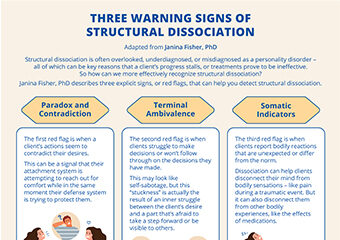You’ve probably heard clients use guilt and shame interchangeably to describe their feelings. But as practitioners, we know that shame and guilt are two very different emotions, each with its own purpose and path to healing. That’s why we created this free infographic designed to help clients understand the key differences between these two emotions […]
[Infographic] – Four Key Ways Collapse/Submit Can Present in a Client
Like many of the emerging defense responses to trauma, the collapse/submit response can be difficult to recognize. So to give you a clearer idea of what this trauma response can look like, we created this free infographic that highlights four key ways it might present in a client. To put this infographic together, we gathered […]
[Infographic] – Three Warning Signs of Structural Dissociation
Working with structural dissociation can be critical in the treatment of severe or prolonged trauma . . . . . . but it’s often difficult to detect. According to Janina Fisher, PhD, structural dissociation is commonly underdiagnosed, or it’s misdiagnosed as a personality disorder. And when left undetected, it could lead to ineffective treatments that […]
[Infographic] – How the Nervous System Responds to Trauma
It can often be difficult for trauma survivors to understand how or why they reacted a certain way during a traumatic experience. Instead of seeing their trauma response as the result of a split-second, unconscious decision made by their nervous system, your client may blame themself for not reacting differently. This can be especially true […]
[Infographic] How Trauma Can Affect Adult Relationships
Left untreated, childhood trauma can reverberate through adult relationships and make it difficult for your client to get close to other people. But Terry Real, MSW, LICSW has a way of thinking about the psyche that can help clients understand the aftereffects of trauma . . . . . . and help practitioners retarget their […]




